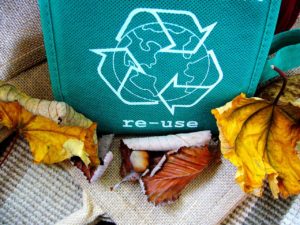 America Recycles Day was started in 1997 by the National Recycling Coalition. Since 2009, it has been a national initiative of Keep America Beautiful. Events are held around the country to educate people about recycling not only for its positive effects on our environment but also for its importance to our economy. According to Brenda Pulley, senior vice president, recycling, of Keep America Beautiful, “America Recycles Day helps to shine a light on our ongoing efforts to educate and inspire people to reduce, reuse and recycle, and when they buy, to buy products made from sustainable and recycled materials.”
America Recycles Day was started in 1997 by the National Recycling Coalition. Since 2009, it has been a national initiative of Keep America Beautiful. Events are held around the country to educate people about recycling not only for its positive effects on our environment but also for its importance to our economy. According to Brenda Pulley, senior vice president, recycling, of Keep America Beautiful, “America Recycles Day helps to shine a light on our ongoing efforts to educate and inspire people to reduce, reuse and recycle, and when they buy, to buy products made from sustainable and recycled materials.”
On November 13, 2015, President Barack Obama issued a Presidential Proclamation declaring November 15 America Recycles Day:
Every American has a role to play in preserving our planet for future generations. Being good stewards of our environment and protecting our natural resources are imperative tasks for ensuring our children and grandchildren live in a clean and sustainable world, and recycling is a pivotal way each of us can do our part. Today, we acknowledge the importance of reusing materials and reducing consumption, and we recognize that a recycling bin may often be a better alternative to a garbage can.
Each year, as much energy is saved recycling and composting as is consumed by 10 million American households. …
Recycling is one way all people can join in the effort of maintaining a sustainable society. Reusing goods and reducing consumption, in addition to donating old or unwanted materials, can have significant impacts on the earth, as well. …
Communities across America must continue promoting activities that encourage people to recycle and to conserve so we do not take for granted today the world our children will inherit tomorrow. We owe it to them to leave behind a stable, secure planet, and that begins with preserving the natural blessings of our Nation. On this day, let us work to fulfill our obligation to our next generation by safeguarding our resources and working with our friends, family, and neighbors to protect the world we share.
On this America Recycles Day we’re recycling our blog post from July 21, 2017, titled Recyclable Materials:
Recycling is beneficial for the environment. It keeps materials out of landfills and helps to reduce the need for harvesting materials from the natural environment. When cities first started recycling programs the assumption was that the cost of the collection and sorting of the materials would be covered by the proceeds of the sale of those materials. In recent years this has not been the case. The value of some materials has dropped dramatically while the cost of recovering them has risen.
Reclaimed paper, a once valuable commodity that was in high demand by the newspaper industry, is one of these materials. As print newspaper circulation dropped dramatically, so did the need for reclaimed paper. Reclaimed plastics is another of these materials. As oil prices remain low, it’s less expensive for manufacturers to make products from new plastic than it is for them to use reclaimed plastic. Since much of the reclaimed materials in the United States are sent overseas, recent legislative action by some countries limiting the amount of imported reclaimed materials has also negatively affected the market making it more difficult to sell such materials.
Today’s market size is the value of a ton of mixed recyclable material for 2011, 2015 and an estimated value for 2017.
Geographic reference: United States
Year: 2011, 2015 and 2017
Market size: $180, $80, and just shy of $100 per ton of mixed recyclable material respectively.
Sources: Paul Singer, “Recycling Market in a Heap of Trouble,” USA Today for the Lansing State Journal, April 21, 2017, page B1; Obama, Barack, “Presidential Proclamation — America Recycles Day, 2015,” The White House, Office of the Press Secretary, November 13, 2015 available online here; Pulley, Brenda, “America Recycles Day Marks 20th Anniversary, Focuses Nation’s Attention on Recycling Every Day,” Keep America Beautiful Press Release, November 2, 2017 available online here; “America Recycles Day,” National Day Calendar available online here.
Image source: 9355, “recycle-reuse-recycling-recyclable-57136,” Pixabay, September 20, 2012 available online here.

 This week many hunters across Michigan are preparing to fan out across the state as regular firearm hunting season begins November 15. According to the Michigan Department of Natural Resources, more than 700,000 hunters in Michigan spent $2.3 billion on trip-related expenses and equipment in 2011, the last year for which data are available.
This week many hunters across Michigan are preparing to fan out across the state as regular firearm hunting season begins November 15. According to the Michigan Department of Natural Resources, more than 700,000 hunters in Michigan spent $2.3 billion on trip-related expenses and equipment in 2011, the last year for which data are available. The Canadian winemaking industry goes back more than 200 years to the early 1800s when Johann Schiller began growing hybridized grapes and making his own wine in Ontario’s Niagara region. The first commercial winery opened in 1866 on Pelee Island. In 1890 there were 41 commercial wineries in Canada, most in Ontario. By 2011 there were 476. Four years later that number grew to 604. Domestic sales of Canadian wines in 2015-2016 were C$2.1 billion. Exports were valued at nearly C$74 million in 2015.
The Canadian winemaking industry goes back more than 200 years to the early 1800s when Johann Schiller began growing hybridized grapes and making his own wine in Ontario’s Niagara region. The first commercial winery opened in 1866 on Pelee Island. In 1890 there were 41 commercial wineries in Canada, most in Ontario. By 2011 there were 476. Four years later that number grew to 604. Domestic sales of Canadian wines in 2015-2016 were C$2.1 billion. Exports were valued at nearly C$74 million in 2015. According to Restaurant.com, Halloween is one of the top 5 busiest days for pizza sales at pizzerias in the United States. The convenience of picking up a ready-made pizza for dinner, or having one delivered, leaves families more free time to prepare for trick-or-treating. In addition, pizza is an often-served and welcome meal at Halloween parties across the country. Forty-one percent of consumers polled for Technomic’s 2016 Pizza Consumer Report said they eat pizza once a week. Two years ago 26% did.
According to Restaurant.com, Halloween is one of the top 5 busiest days for pizza sales at pizzerias in the United States. The convenience of picking up a ready-made pizza for dinner, or having one delivered, leaves families more free time to prepare for trick-or-treating. In addition, pizza is an often-served and welcome meal at Halloween parties across the country. Forty-one percent of consumers polled for Technomic’s 2016 Pizza Consumer Report said they eat pizza once a week. Two years ago 26% did. For many years people have been buying books, clothing, and housewares online. Why not groceries? The grocery industry in the United States generates more than $600 billion in sales. Nearly everyone shops for groceries and an overwhelming majority shop for groceries at least once a week. Online grocery-shopping services offer the consumer convenience, but many times this convenience comes at a price. Because the consumer is paying someone else to shop for them, in order to pay these employees companies may charge higher prices for the groceries themselves and charge for shipping or delivery. Also, the consumer has to trust that the online grocery-shopping service employees will select the best produce, meat, and other perishable items and deliver them to their door in a timely manner and in good condition.
For many years people have been buying books, clothing, and housewares online. Why not groceries? The grocery industry in the United States generates more than $600 billion in sales. Nearly everyone shops for groceries and an overwhelming majority shop for groceries at least once a week. Online grocery-shopping services offer the consumer convenience, but many times this convenience comes at a price. Because the consumer is paying someone else to shop for them, in order to pay these employees companies may charge higher prices for the groceries themselves and charge for shipping or delivery. Also, the consumer has to trust that the online grocery-shopping service employees will select the best produce, meat, and other perishable items and deliver them to their door in a timely manner and in good condition. From 2012 to 2016, the number of craft breweries in the United States more than doubled from 2,420 to 5,234. In 2016, sales of craft beer made up 22%—$23.5 billion—of the overall beer market.
From 2012 to 2016, the number of craft breweries in the United States more than doubled from 2,420 to 5,234. In 2016, sales of craft beer made up 22%—$23.5 billion—of the overall beer market.  The World Wide Web. A decentralized network of data stored on servers all around the world. But many countries—China, Russia, Germany, and Belgium, to name a few—are enacting laws requiring multinational companies to store and process country-specific data on local servers. According to the source, relaxing such restrictions has become a priority of President Donald Trump’s administration as they negotiate trade agreements, including the upcoming renegotiation of NAFTA.
The World Wide Web. A decentralized network of data stored on servers all around the world. But many countries—China, Russia, Germany, and Belgium, to name a few—are enacting laws requiring multinational companies to store and process country-specific data on local servers. According to the source, relaxing such restrictions has become a priority of President Donald Trump’s administration as they negotiate trade agreements, including the upcoming renegotiation of NAFTA. Although the Federal government considers possession of marijuana illegal and classifies marijuana as a Schedule I substance, one that has “no currently accepted medical use and a high potential for abuse” according to the Controlled Substances Act of 1970, all but eleven of the 50 states have decriminalized the possession of small amounts of marijuana at the state level. As of the end of 2016, twenty-four states have legalized some form of medical marijuana and eight states and the District of Columbia have legalized marijuana for recreational use. While the legalization of marijuana for recreational use is a new phenomenon—Colorado and Washington were the first states to legalize this activity in 2012—decriminalization at the state level began in 1973 and California was the first to legalize medical marijuana in 1996. Despite legalizing this drug, some states and municipalities are struggling with how to regulate this new industry. In Michigan, where medical marijuana has been legal since 2008, the governor didn’t sign legislation to regulate the industry until September 2016. Under the new regulations, the House Fiscal Agency estimates that annual medical marijuana sales will total $771 million, generating $21.3 million in state tax revenue. Michigan has 244,125 registered medical marijuana users and 40,702 registered caregivers.
Although the Federal government considers possession of marijuana illegal and classifies marijuana as a Schedule I substance, one that has “no currently accepted medical use and a high potential for abuse” according to the Controlled Substances Act of 1970, all but eleven of the 50 states have decriminalized the possession of small amounts of marijuana at the state level. As of the end of 2016, twenty-four states have legalized some form of medical marijuana and eight states and the District of Columbia have legalized marijuana for recreational use. While the legalization of marijuana for recreational use is a new phenomenon—Colorado and Washington were the first states to legalize this activity in 2012—decriminalization at the state level began in 1973 and California was the first to legalize medical marijuana in 1996. Despite legalizing this drug, some states and municipalities are struggling with how to regulate this new industry. In Michigan, where medical marijuana has been legal since 2008, the governor didn’t sign legislation to regulate the industry until September 2016. Under the new regulations, the House Fiscal Agency estimates that annual medical marijuana sales will total $771 million, generating $21.3 million in state tax revenue. Michigan has 244,125 registered medical marijuana users and 40,702 registered caregivers. College football guarantee games are mostly non-conference games arranged by contract among opponent schools, in most cases many years in advance. These contracts involve payment to one or both of the schools involved. While these types of games have been in existence for many years, payments have skyrocketed in the past decade and a half from several hundred thousand dollars per contract to several million dollars per contract.
College football guarantee games are mostly non-conference games arranged by contract among opponent schools, in most cases many years in advance. These contracts involve payment to one or both of the schools involved. While these types of games have been in existence for many years, payments have skyrocketed in the past decade and a half from several hundred thousand dollars per contract to several million dollars per contract. Several decades ago thrifting—shopping at used merchandise stores—was associated with poverty. More recently while some continue to shop at used merchandise stores to save money, many see thrifting as a lifestyle choice, a way to find inexpensive, unique pieces for their wardrobe or to find pieces to repurpose for do-it-yourself projects. The younger generation, especially, has embraced thrifting. Perhaps as a reflection of that, the 2012 Macklemore song “Thrift Shop” became a hit. The official music video on YouTube, as of May 2017, had more than 1 billion views and more than 5 million likes.
Several decades ago thrifting—shopping at used merchandise stores—was associated with poverty. More recently while some continue to shop at used merchandise stores to save money, many see thrifting as a lifestyle choice, a way to find inexpensive, unique pieces for their wardrobe or to find pieces to repurpose for do-it-yourself projects. The younger generation, especially, has embraced thrifting. Perhaps as a reflection of that, the 2012 Macklemore song “Thrift Shop” became a hit. The official music video on YouTube, as of May 2017, had more than 1 billion views and more than 5 million likes.